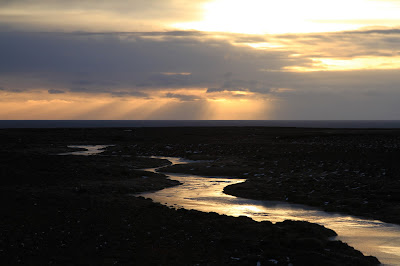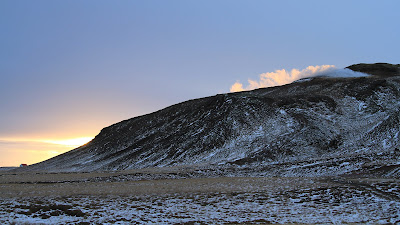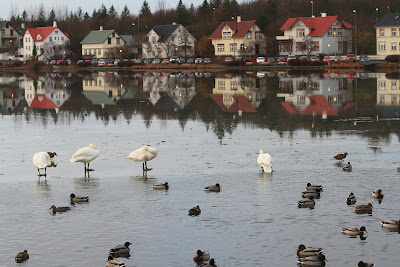Upper Left: Near Brú, Upper Right: View South from Reykjanes Peninsula. Lower Left: The Sun Voyager in Reykjavik, Lower Right: View South from West Shore of Þingvallavatn




So you are thinking about going to Iceland in the winter? We decided to go over Thanksgiving 2012 for 5 days and 4 nights and here I give our experience. I’ll summarize by saying we had a great time, would recommend going, and we will definitely be going back in the summer - likely for a more extensive tour of the island and hiking. For this little jaunt, we really only saw a tiny sliver of the island.
Our experience in Iceland was enhanced with the Locatify SmartGuide North Altlantic Application (iTunes link and Google play link). We purchased a couple of the tours (in English and Italian) and were happy with the quality of these guides. I wish more guides like this were available. We highly recommend them if you are traveling to destinations in the North Atlantic.
Light
Light is your biggest challenge if going to Iceland in the winter. You have to be efficient with your time. You need to plan your day to get the most out of it, especially when seeing natural attractions. Get to your first place at, or just after sunrise. You might save the spa (Blue Lagoon) and pools (popular in Iceland) and other lounging for the dark hours.
Reykjavík’s coordinates are 64°08′N 21°56′W and when you put this information into a daylight calculator like the one at the at the U.S Naval Observatory site you can get a sense of the light you’ll have to work with. For example, for Nov 20th (our first day there), sunrise was at 10:14am and sunset at 16:12 - about 6 hours of light. Not much to work with, but do-able.
Left: Near Krýsuvík, Center: Imagine Peace Tower, Right: View from Reykjavik



The Blue Lagoon
Is it worth it? In our opinion, yes. You’ve come all this way, why not try it? Yes, there are other places in the country to go and try geothermal waters, some more “natural” then the Blue Lagoon, but they are not as convenient as the Blue Lagoon and in winter, this is your best bet. If you have an early morning flight, like we did, you can’t just pop over to the Blue Lagoon because they don’t open until 10am in the winter. We went at 10:30am on the grey day we arrived. We spent 2-3 hours in the lagoon and then 1 hour at the Lava restaurant (good food). We had a great time. Was it necessary to go in the day time, probably not, but that’s what worked for our schedule. We met other travelers who had received the advice to go to the Blue Lagoon at night, especially in winter, to save your daylight hours for other activities.
When we were at the Blue Lagoon, it seemed like waves of people came and went. A group of chattering 20-somethings were there and then they weren’t and the lagoon was deserted. We floated on our backs for a while and when we came to, some large Nordic people started invading the lagoon. So, expect to share the waters with many other folks or not.
A Sampling of Museums in Reykjavík
Off season, you can find many attractions closed or with shortened hours, so check ahead of time. We made a couple of missteps in selecting the most interesting museums. Here’s our take:
- Listasafn Íslands - National Gallery of Iceland - a small gallery that features permanent works by Icelandic artists like Ásgrímur Jónsson (1881 - 1962), Jóhannes S. Kjarval (1885 - 1972), and Kristján Magnússon (1903 - 1937). Also, there are temporary exhibitions. We saw Rek/Drift (2012) by Anna Hallin & Olga Bergman and Archive - Endangered Waters (2003), by Rúri which we saw at a biennale years earlier.
- Reykavik Art Museum - Reykjavík Art Museum is located in three different buildings, Hafnarhús on the waterfront, Kjarvalsstaðir on the Miklatún Park and the Ásmundur Sveinsson Sculpture Museum near Laugardalur. We saw Hafnarhús and Kjarvalsstaðir and missed Ásmundur.
For our tastes, Hafnarhús (Harbor House) was a great find. It’s conveniently located in the heart of Reykjavík and the exhibitions we saw were interesting. Its exhibitions “tend toward the progressive and experimental.”
- Imagine Peace Tower We took a boat there with Elding.
- Hallgrimskirkja - This Lutheran church bell tower can be visited (elevator only) and from the top you can take in Reyjkavik
- National Museum of Iceland - We unfortunately short changed ourselves on time spent at this interesting museum. The permanent exhibition walks chronologically through Iceland’s history. It features interesting exhibits and a good audio guide.
The standouts for us were the Hafnarhús, the National Museum of Iceland, and the Imagine Peace Tower. The National Gallery of Iceland was fine, just very small and not the kind of expansive experience we were looking for. Kjarvalsstaðir - named after the painter Jóhannes S. Kjarval (1885 - 1972) features his work in a permanent collection, temporary exhibitions, and a café. The museum with the surrounding park might have been a better destination and place to hang out on a different day for us had we not slip-slided our way there on foot trying to get there before they closed. The Imagine Peace Tower is a great activity for the evening hours when the tower is lit (only certain times of the year).
Left: Tjörnin Lake, Reykjavik, Center: Harfnarhús Museum - “HA” by Sara Björnsdóttir, Right: View from Hallgrímskirkja



The Golden Circle
We chose not to take a tour bus to see the Golden Circle sites because we don’t care for bus tours and we didn’t want to cram the tour into one day. Instead, we drove ourselves and split it into two days. Day one, we saw Kerið, Skálholt, Gullfoss, and Geysir. Day two, we spent at Þingvellir. We still missed a couple of attractions that we might have squeezed in the second day. If you don’t care to linger at the Golden Circle sites too long and you want to sit back and let someone else do the driving and navigation, then the bus tour is good a good option. But, don’t be afraid to do it on your own.
Lodging, Eating, Coffee
The first two nights we stayed inside the Golden Circle at the wonderful Grimsborgir. We took dinner at the hotel our first night and it was delicious. The second evening we ate at the popular Fjöruborðið (which means roughly “by the seashore”) - which was good, but we are going to give the nod to the sumptuous spread at Grimsborgir.
The remaining two nights we stayed at the Reykjavík Residence in the heart of Reykjavík. This hotel has food in the small kitchenette so you prepare your own breakfast, if you want. We didn’t want to brew our own coffee, so we headed over to Kaffitár on Bankastraeti 8. We found Kaffitár coffee to be consistently very good at the various locations we tried it. In a local bakery, Sandholt, we sampled I believe Kaffismiðja Íslands beans. (Kaffismiðja Íslands is just around the corner from Sandholt, but they were closed when we tried to go there.) An interesting article on Nordic Coffee Culture, Reykjavik Coffee Guide, talks about the coffee scene in Reykjavík. As I write this I realized, boy, we did drink a lot of coffee there. On the negative side, we saw that in a few locations they served Chaqwa coffee (Coca-Cola brand); we found it to be horrible.
The first night in Reykjavík we ate a very satisfying dinner at the Sjávargrillið Seafood Grill and the next day we had lunch at Icelandic Fish and Chips.
Left: Icelandic Horses Near Reykholt, Center: View North from Þingvellir toward Armansfell, Right: Þingvellir, View South Toward Þingvallavatn



Getting Around
The roads in and around the Golden Circle and Reykjavík were fine to drive on, at least when were there. We rented a car (Europcar at the airport) and had no problems. The car had studded tires which we were grateful for because the roads were icy. The signage for key attractions is subtle, but otherwise fairly well marked. In particular, look for the Place of Interest Sign ⌘, also known as Saint John’s Arms or Saint Hannes cross, or that symbol on an Apple keyboard.
Be careful walking because we found sidewalks to be quite slippery at times. In Reykjavík, some sidewalks were heated and stayed ice free and others were icy. You just have to keep your eyes open and wear sensible shoes.
The Reykjavík Grapevine is a good resource to see what is going on in Reykjavik and it has some interesting articles. One that we read in Issue 17, 2012 was titled Architectural Acne where the author, Hallgrimur Helgason, “ponders Iceland’s tradition of building ugly houses”. We were wondering about some of the architecture! (However, the Harpa is really cool. We only walked around the inside.)
Language
The language was pretty opaque to us, but all the locals we met had good English skills. “Island” equals “Iceland” in the Icelandic language. It took us a while to realize this. Most Icelandic web sites have an “English” option, or if they don’t, you can grab the text and stick it in your favorite translator (google for example). After returning, we ordered fishing flies for a friend from http://www.flugan.is/ because we didn’t have chance to pick them up when there and we learned such interesting things from the translator like “Bleik og blá með kúlu” is “Pink and blue with a ball”! Speaking of purchases, if you forget to pick up something while you are in Iceland, try Shop Icelandic. Our fish snacks just arrived the other day.
Finally, speaking of language, we were sitting in our comfy cottage house at Grimsborgir one evening and flipped on the radio. We discovered http://www.ruv.is/vidsja which is a show on RAS1, part of the Icelandic National Broadcasting Service (RUV). We were mesmerized by the sounds of the language - though we couldn’t understand a darn thing - but it sounded serious and soothing. In the least, it is a good way to get acquainted with the sound of the language before you go.
Left: View of Burfell Table Volcano from Kerið Volcano Crater, Center: Strokkur Geysir, Left: Brú Near Gesysir



Left: Gullfoss, Center: Hallgrímskirkja – Reykjavik, Left: Strokkur Bubble About to Burst

































































